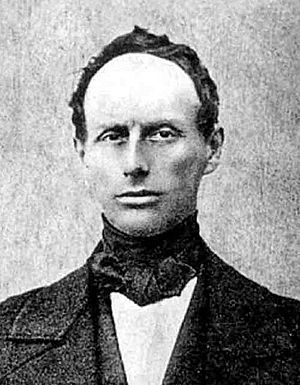Christian Doppler facts for kids
Quick facts for kids
Christian Doppler
|
|
|---|---|
 |
|
| Born | 29 November 1803 Salzburg, Electorate of Salzburg
|
| Died | 17 March 1853 (aged 49) Venice, Kingdom of Lombardy–Venetia, Austrian Empire
|
| Nationality | Austrian |
| Alma mater | Imperial–Royal Polytechnic Institute Prague Polytechnic |
| Known for | Doppler effect |
| Scientific career | |
| Institutions | Prague Polytechnic Academy of Mines and Forests University of Vienna |
| Notable students | Gregor Mendel |
Christian Andreas Doppler (born 29 November 1803 – died 17 March 1853) was an important Austrian mathematician and physicist. He is famous for discovering a scientific rule called the Doppler effect. This rule explains how the sound or light waves we observe change if the thing making the waves is moving towards or away from us. He first used this idea to understand the colors of binary stars, which are two stars orbiting each other.
Contents
Who Was Christian Doppler?
Christian Doppler was born in Salzburg, Austria, in 1803. After finishing high school, he studied philosophy in Salzburg. He then focused on mathematics and physics at the Imperial–Royal Polytechnic Institute, which is now known as TU Wien. He became an assistant there in 1829.
Early Life and Education
In 1835, Doppler started working at the Prague Polytechnic, now called the Czech Technical University in Prague. He officially became a professor there in 1841.


Discovering the Doppler Effect
One year later, when he was 38 years old, Doppler gave a lecture to the Royal Bohemian Society of Sciences. After this, he published his most famous work. The book was titled On the colored light of the binary stars and some other stars of the heavens.
In this important book, Doppler introduced his principle, which we now call the Doppler effect. He suggested that the frequency of a wave (like sound or light) changes depending on how fast the source of the wave and the person observing it are moving relative to each other. He tried to use this idea to explain why some binary stars appeared to have different colors.
What is the Doppler Effect?
Imagine a siren on an ambulance. When the ambulance is coming towards you, the sound waves are squished together. This makes the siren sound higher pitched. As the ambulance drives away, the sound waves spread out. This makes the siren sound lower pitched. This change in pitch is the Doppler effect for sound. The same idea applies to light waves, affecting their color.
Fizeau's Contributions
Another physicist, Armand Hippolyte Fizeau, also helped understand the Doppler effect. In France, it's sometimes called the Doppler-Fizeau Effect. Fizeau helped explain how this effect works with light. He also created mathematical rules for it. In 1848, he predicted that the frequency of a wave would shift if the source and observer were moving. This led to the idea of "blue shifts" and "red shifts" in the light from stars. A blue shift means light waves are squished (moving closer), and a red shift means they are stretched (moving away).
Later Career and Legacy
Doppler continued to work as a professor at the Prague Polytechnic. He wrote more than 50 articles about mathematics, physics, and astronomy. In 1847, he moved from Prague to become a professor at the Academy of Mines and Forests. This school is now part of the University of Miskolc in Selmecbánya (which is now Banská Štiavnica, Slovakia).
In 1849, he moved to Vienna. His research was briefly interrupted by the European Revolutions of 1848. During the Hungarian Revolution of 1848, he went to Vienna for safety. There, in 1850, he was chosen to lead the Institute for Experimental Physics at the University of Vienna.
While at the University of Vienna, Doppler helped guide a young student named Gregor Mendel. Mendel later became known as the "father of genetics" because of his important work on how traits are passed down.
Christian Doppler passed away on 17 March 1853, at the age of 49. He died from a pulmonary disease (a lung illness) in Venice, which was then part of the Austrian Empire. His grave was found by Dr. Peter M. Schuster. It is located just inside the entrance of the Venetian island cemetery of San Michele.
What Was His Real Name?
There has been some confusion about Doppler's full name. He always called himself Christian Doppler. However, his birth and baptism records show his name as Christian Andreas Doppler. About 40 years after he died, an astronomer named Julius Scheiner mistakenly called him Johann Christian Doppler. Many people have copied this mistake since then.
Remembering Christian Doppler
On 29 November 2017, Google celebrated Christian Doppler's 214th birthday. They honored him with a special picture on their homepage called a Google Doodle.
See also
 In Spanish: Christian Andreas Doppler para niños
In Spanish: Christian Andreas Doppler para niños

